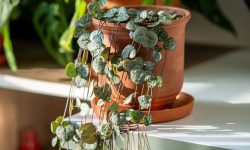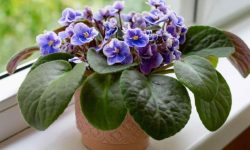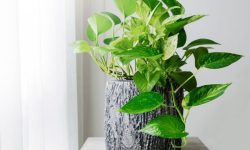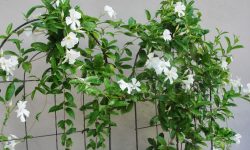Chinese evergreen (Aglaonema) is a popular houseplant among indoor plant enthusiasts due to its vibrant foliage and easy-care nature. But it can be disheartening to witness the leaves of your Chinese evergreen curling despite providing ultimate care.
Chinese evergreen leaves curling is an indicator of an underlying issue that needs attention. Our experts wrote this article to share various factors that can cause Chinese evergreen leaves to curl. We have also included the solutions and preventive measures.
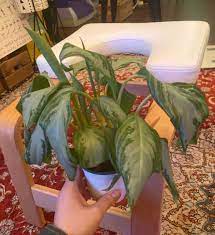
12 Causes of Evergreen Leaves Curling
Aglaonema leaves curling can be disheartening especially if you are providing ultimate care. Here are the possible causes and their respective solutions:
Natural Aging Leaves
Chinese evergreen plants go through a natural aging process. The older leaves may naturally curl and droop since this is a normal part of the plant’s growth cycle. These aging leaves are no longer efficient in photosynthesis and can take away valuable nutrients from the rest of the plant.
It’s best to remove these older leaves to promote new growth and maintain the plant’s overall health. Ensure you use clean, sharp pruning shears when removing aged foliage to minimize the risk of introducing diseases.
Regular pruning is necessary to maintain a healthy and aesthetically pleasing Chinese evergreen plant. Trim off the older leaves close to the base of the stem, making a clean cut.
This will redirect the plant’s energy toward new growth. By regularly removing aged foliage, you can prevent any potential nutrient depletion and maintain a balanced and vibrant appearance for your Chinese evergreen.
Overwatering
Overwatering is a common issue that can lead to leaf curling in Chinese evergreen plants. When the roots are constantly saturated, they become deprived of oxygen, leading to root rot and other moisture-related problems. The leaves may curl, turn yellow or brown, and develop mushy spots.
It is crucial to establish a proper watering routine for your Chinese evergreen. Allow the top inch of soil to dry out before watering again. Stick your finger into the soil to check the moisture level or use a moisture meter.
When watering, do so thoroughly until the excess water drains out from the bottom of the pot. Ensure proper drainage in the pot by using well-draining soil and a container with drainage holes.
Avoid leaving the plant sitting in standing water, as this can lead to waterlogging and root rot. Develop a strict watering routine to keep your houseplant healthy.
Underwatering
Underwatering can also cause leaf curling in Chinese evergreen plants. When the plant doesn’t receive enough water, it starts to conserve moisture by curling its leaves. The leaves may become limp, and dry, and lose their vitality.
To prevent underwatering, make sure you water your Chinese evergreen thoroughly when the top inch of soil feels dry to the touch. Pour water evenly over the soil until it starts to drain from the bottom of the pot.
Avoid letting the soil become bone dry or waterlogged. Using a moisture meter or checking the soil moisture with your finger can help you determine the watering needs of your plant.
Low Humidity
Chinese evergreens thrive in moderate to high-humidity environments. When the air around the plant is too dry, the leaves can lose moisture faster than they can absorb it. This can result in leaf curling and browning at the edges.
Increase humidity around your Chinese evergreen plant to prevent leaf curling due to low humidity. Place a small humidifier near the plant to maintain a consistent level of humidity.
You can also create a humidity tray by filling a shallow tray with water and placing the pot on top, making sure the water doesn’t touch the bottom of the pot. It will create a humid microclimate around the plant.
Mist the leaves regularly using a spray bottle filled with clean water. This will provide a temporary boost in humidity, but it’s important not to overdo it, as excessive moisture on the leaves can lead to fungal diseases.
Temperature
Extreme temperature fluctuations can stress Chinese evergreen plants, leading to curling leaves. Chinese evergreens prefer temperatures between 65-80°F (18-27°C). Exposure to cold drafts, hot air vents, or sudden temperature changes can cause the leaves to curl and become distorted.
Place your Chinese evergreen in an area where it is protected from drafts and extreme temperature changes. Avoid placing it near air conditioning units, heating vents, or windows that receive direct sunlight or cold drafts. Maintain a stable temperature within the preferred range to ensure the plant’s well-being.
Direct Light
While Chinese evergreens can tolerate low light conditions, exposure to excessive direct sunlight can cause leaf curling and leaf burn. Intense sunlight can scorch the leaves and disrupt the plant’s photosynthesis process.
Place your Chinese evergreen in a location with bright, indirect light. A few feet away from a north or east-facing window is usually ideal. If the plant is exposed to direct sunlight, move it to a spot where it receives filtered light or use sheer curtains or blinds to diffuse the sunlight.
Adjust the plant’s position periodically to ensure even light exposure on all sides, promoting balanced growth and preventing leaf curling.
Unfavorable Water Quality
Tap water often contains chemicals such as chlorine or fluoride, which can be harmful to Chinese evergreen plants. These chemicals can accumulate in the soil over time, causing leaf curling and discoloration.
Consider using filtered or distilled water when watering your Chinese evergreen. Filtered water helps remove harmful chemicals and minerals that can negatively impact the plant’s health.
Allow tap water to sit overnight before using it, as this allows chlorine to dissipate naturally. If you don’t have access to filtered or distilled water, using rainwater or allowing tap water to sit for 24 hours can also help reduce the concentration of harmful chemicals.
Overfertilization
Overfertilization can lead to a buildup of salts in the soil, which can cause leaf curling and other nutrient-related problems. When the soil becomes too concentrated with salts, it interferes with the plant’s ability to take up water, resulting in leaf wilting and curling.
Use a balanced, water-soluble fertilizer specifically formulated for houseplants. Follow the recommended dosage provided by the manufacturer, as overfertilization can be detrimental to the plant’s health. During the growing season (spring and summer), fertilize your Chinese evergreen once a month.
Flush the soil occasionally by thoroughly watering the plant until water drains freely from the bottom of the pot. This will help remove excess salts and maintain a healthy nutrient balance in the soil.
Undernutrition
A lack of essential nutrients can weaken Chinese evergreen plants, making them more susceptible to leaf curling. Insufficient nutrients can result from infrequent or inadequate fertilization.
Regular fertilization is essential to ensure your Chinese evergreen receives the necessary nutrients for healthy growth. Use a balanced houseplant fertilizer with a ratio such as 10-10-10 or 20-20-20.
Dilute the fertilizer to half-strength or follow the manufacturer’s instructions. Apply the fertilizer during the growing season (spring and summer) every four weeks. This will provide the plant with a consistent supply of nutrients, helping to prevent leaf curling due to undernutrition.
Pest Infestation
Insect pests like spider mites, mealybugs, or scale insects can cause leaf curling and damage in Chinese evergreen plants. These pests extract sap from the leaves, weakening the plant and disrupting its normal growth.
Regularly inspect your Chinese evergreen for signs of pests, such as tiny webs, sticky residue, or visible insects. If you notice an infestation, isolate the plant to prevent the pests from spreading to other plants. Treat the infested plant using appropriate organic or chemical insecticides by following the instructions on the label.
For minor infestations, you can manually remove the pests using a cotton swab dipped in rubbing alcohol. Be sure to maintain good plant hygiene by removing dead leaves and debris to prevent pest infestations.
Plant Disease
Fungal or bacterial infections can also cause leaves to curl in Chinese evergreen plants. Overwatering, poor air circulation, and high humidity can create favorable conditions for the development of diseases.
Ensure good air circulation around your Chinese evergreen by providing adequate spacing between plants and avoiding overcrowding. Avoid overwatering and allow the soil to dry slightly between watering to prevent the growth of fungal pathogens.
If you notice signs of disease, such as discolored or spotted leaves, lesions, or a foul odor, promptly remove the affected leaves or sections of the plant. Use fungicides or bactericides as directed by the manufacturer to control the spread of the disease.
Acclimation
When you bring a Chinese evergreen plant into a new environment, it may undergo a period of adjustment known as acclimation. During this time, the plant may exhibit temporary leaf curling as it adapts to the new conditions. Acclimation can be triggered by changes in light levels, temperature, humidity, or air quality.
During the acclimation period, it’s important to maintain stable conditions for your Chinese evergreen plant. Avoid making sudden changes to its environment, such as moving it from low light to direct sunlight or exposing it to extreme temperature fluctuations.
Provide consistent care and give the plant time to adjust. In most cases, the leaf curling associated with acclimation will resolve on its own within a few weeks.
Final Thoughts From Experts
To maintain healthy and vibrant Chinese evergreen plants, it is essential to provide them with the right care and environment. Avoid overwatering or underwatering, maintain moderate humidity, provide suitable light conditions, and fertilize appropriately.
Regularly inspect your plant for pests and diseases, addressing them promptly to prevent leaf curling. Keep in mind that some leaf curling may occur naturally as the plant ages. By following these preventive measures and promptly addressing any issues to ensure your Chinese evergreen thrives.
People Who Read This Also Read:


